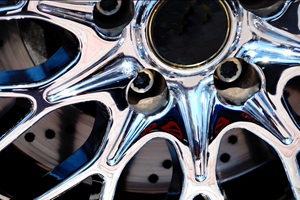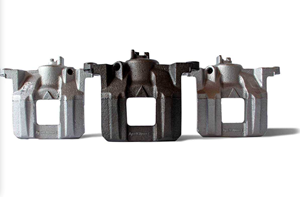How to Minimize Fading of Anodized Colors
All color-anodized parts fade, but if the process is optimized, you can expect years with minimal loss in color, says Reliant Aluminum Products’ Mark Jozefowicz.
Q. One of our customers recently complained that the color of parts we anodized for them had faded within a few weeks of outdoor service. What can be done to address this problem?
A. I’m going to assume that you used an organic dye, the most common method of coloring anodized aluminum. Unfortunately, all dyes fade to some extent when they are exposed to ultraviolet light. The good news is that there are steps that you as the anodizer can take to minimize this unwanted effect.
Dye Choice
Every dye is unique in its chemistry and each is rated for UV fade resistance. A numerical rating of 5 to 8 is generally noted on the technical data sheet. ISO 2135 is the procedure used to determine the rating. In it, a UV chamber is calibrated to determine the duration of an exposure cycle. A dyed panel is then exposed to this cycle for as many times as it takes to fade to roughly 75 percent of its original color. A rating of 6 indicates the dye took twice as many cycles to fade compared to one rated 5. Likewise, 7 is twice as fade-resistant as 6, and 8 twice that of 7. Those that are rated higher than 8, are designated 8* or 8+.
If the specified color allows, changing your dye to one of a higher rating will improve the fade resistance of your finished part. This can easily be done if the color is black, since many highly rated black dyes are available. Highly rated decorative colors also exist, but the choice is somewhat limited, and you may have to discuss available color options with your customer.
Dye Saturation
By “saturation,” I mean the amount of dye adsorbed by the coating. Even if you use a highly rated dye, to achieve excellent light-fastness, you’ve got to get a lot of dye to adsorb onto the pore walls within the coating. Fastness properties of deeper shades are much better than lighter shades. Very light shades of any dye will fade relatively quickly. The most fade-resistant color coatings are reasonably thick, porous and fully saturated with dye. In fact, when dyes are rated by the suppliers, test panels are given Type II coatings approaching 1 mil in thickness; they are colored in highly active dye baths; and lengthy immersion times are used to ensure full saturation, hence best results. Type III coatings generally won’t hold up very well due to the relatively low surface area of pore wall, making them poorly suited for allowing maximum dye saturation.
As mentioned, the activity of a dye impacts maximum saturation. Concentrated, freshly made up dye baths are highly active, but over time, as contaminants are introduced and dye is consumed, their activity declines. When longer and longer immersion times are needed to achieve the color target, you know that your dye activity has slipped and full saturation may not be possible. To maximize activity, you should ensure that the bath concentration, pH and temperature are where they are supposed to be and add a buffer. Dye buffers not only help to hold pH steady, they also boost the activity of the dye.
Seal Quality
The third and equally important component in achieving a fade-resistant color is a high-quality seal. For any given seal chemistry, quality is impacted by silicate or phosphate contamination, temperature, pH, and immersion time. As a general rule, look to the technical data sheet of the seal product you are using for guidance. Those who take short cuts when they seal will produce parts that fade. Nickel seals are generally preferred because for many dyes, nickel ions bond to the dye molecules, affording added protection against UV radiation. Nickel-acetate products are generally used and they work well, but it’s worth mentioning that nickel-fluoride room-temperature seals often produce better results.
In summary, there are several actions you can take towards improving the fade resistance of your color anodized parts. First, check the light fastness rating of your dye. If the number is 6 or 7, consider moving to a dye rated 8 or 8*. If the parts are not black, doing so may affect the shade, so you may have to discuss this option with your customer. Second, make sure your dye is in good working order and that the concentration, pH and temperature are correct. Consider adding a dye buffer to improve the dye activity. Older dye baths that are beyond salvage may need to be decanted or dumped. Third, make sure that your coating is thick, with adequate porosity, and allow the part to fully saturate with dye. Finally, check to see if your seal quality is acceptable. There are a variety of tests that can be used to determine this.
You should be aware that all color-anodized parts fade, but if the process is optimized, you can expect years, if not decades of outdoor exposure with minimal loss in color.
Mark Jozefowicz is with Reliant Aluminum Products. Visit reliantaluminumproducts.com.Related Content
Nickel Electroplating
Applications, plating solutions, brighteners, good operating practices and troubleshooting.
Read MoreA Chromium Plating Overview
An overview of decorative and hard chromium electroplating processes.
Read MoreCalculating the Cost of Powder Coating
How can you calculate the cost of powder coating a component if you only know its surface area? Powder coating expert Rodger Talbert has the answer.
Read MoreRead Next
The 2024 Ford Mustang: All the Colors Available
Although Chevrolet has announced the end of the Camaro and Dodge is offering “Last Call” editions of the Charger and Challenger, the Ford Mustang is launching to its seventh generation.
Read MorePowder Coating 4.0: Smarter, Faster, More Efficient and Connected
New tools reduce cost and waste, lower manufacturing footprint of powder coating operations.
Read MoreEpisode 42: An Interview with Robin Deal, Hubbard-Hall
Hubbard-Hall wastewater treatment specialist Robin Deal discusses the latest trends in wastewater management.
Read More

























